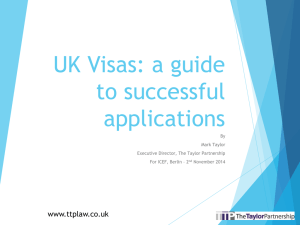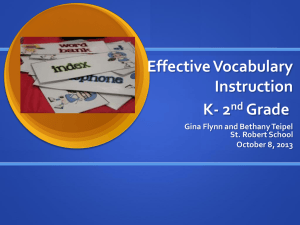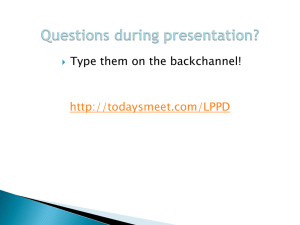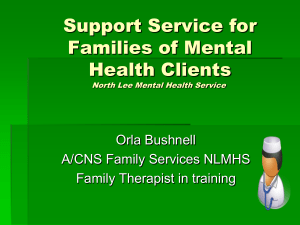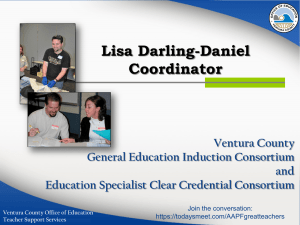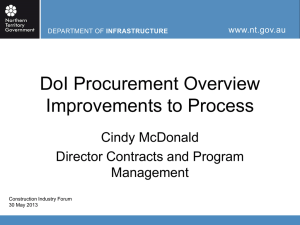Response to Intervention and ELA Plan
advertisement
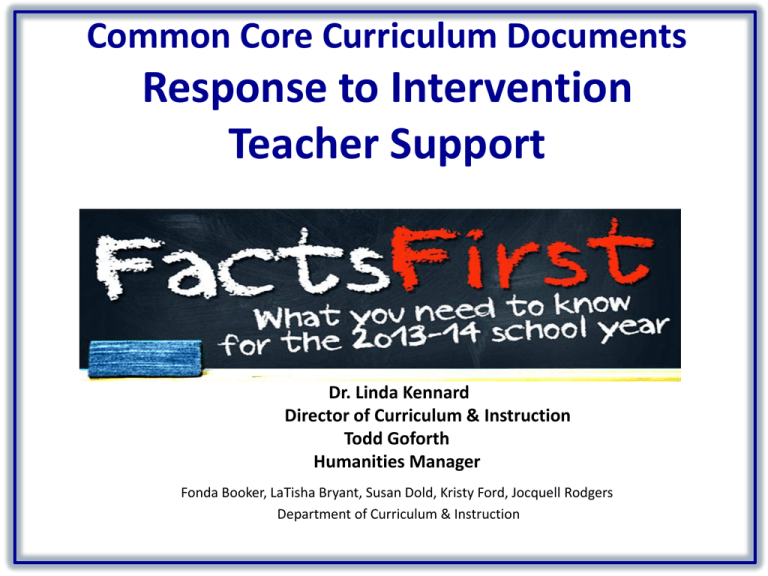
Common Core Curriculum Documents Response to Intervention Teacher Support Dr. Linda Kennard Director of Curriculum & Instruction Todd Goforth Humanities Manager Fonda Booker, LaTisha Bryant, Susan Dold, Kristy Ford, Jocquell Rodgers Department of Curriculum & Instruction ELA and Mathematics Focus Areas • Common Core Aligned Curriculum Documents • RTI2 Guidelines • Teacher Support Today’s Agenda • Curriculum Documents • RTI2 Literacy Guidelines Time Allotments • Tiered Intervention • Teacher Support Literacy Framework Goals Curriculum (Tier I) Intervention Assessment (Tier I) Teacher Support (Tier I) Increase % P/A Close Gaps RTI2 Implementation Common Core – Model Content Framework New Curriculum Maps and Pacing Guides Tier II Tier III Reading Small Group + Intervention Reading Small Group + Intervention Reading Benchmarks, K-9 Interim PARCC-Like Assessments Performance Assessment Tasks in Curriculum Content Specialist School Deployment CCSS Ongoing Professional Development Blended Reading Course (Small Group + Online) Elementary Only Rationale for Curriculum Revision • To bring consistency across all schools • To more tightly align instruction with the Common Core State Standards • To better prepare our students for the PARCC Assessments that are coming in 2014-2015 How Will PARCC Be Different? For teachers and schools: Computer-based testing will boost student engagement and access More efficient than pencil-and-paper tests Timely data during the year will aid instruction, professional development Tests will assess the full range of student performance, not just students in the middle Tests will measure student growth at all levels as well as focusing on proficiency 7 The PARCC Model Content Framework Item Development: ELA/Literacy • Claims – ELA/Literacy: On track or college- and career-ready, supported by three major claims: reading complex texts (literature, informational texts, vocabulary); writing using and responding to sources (written expression, conventions); research • Item types focus on framing critical advances in the standards: – – – – – – Reading complex texts Reading a range of texts Writing effectively when using and/or analyzing sources Conducting and reporting on research Speaking and listening Using knowledge of language effectively when reading, writing, and speaking 3 Steps to Curriculum Success 1. PARCC Planning Guide 2. Pacing Guides 3. Curriculum Map PARCC Planning Guide PARCC Planning Guide Q1 Grade 7 Reading Complex Text Writing to Texts 1 Extended Text Routine Writing Literature A Christmas Carol Acts I and II (drama) Every Quarter 3-5 Short texts Research Project 4-6 Analysis 2-3 Literature texts Students must write daily Focus on The Dinner Party (fiction) and consistently during The Treasure of Lemon Brown (fiction) arguments reading of short and Analyses should The Bear Boy (fiction) extended texts to show be written to Rikki-tikki-tavi (fiction) evidence of their develop an argu The Third Wish (fiction) application of inferring, ment based on The Amigo Brothers (fiction) summarizing, questioning the evidence, and connecting. Zoo (fiction) ideas, and facts Ribbons (fiction) gathered through Students must write from Sorry, Wrong Number (drama) the reading of consistently, during and from Dragonwings (drama) short and after reading short and 1-2 Informational texts extended texts. extended texts, and Keeping It Quiet (expository) respond to text On the Boardwalk (expository) dependent questions. A Christmas Carol (argument) Toned-down Christmas Carol has more spirit (argument) Charles Dickens’s A Christmas Carol (expository) Veteran Returns, Becomes Symbol (argument) The Wrong Orbit: Senator Has No Legitimate Business Blasting into Space (argument) For Reading and Writing in Each Module 1-2 Narratives 1 Research Project Write at least one narrative that conveys real or imagined experiences and reflect the craft of literary elements outlined in Reading standards 2-6. Writing standards 7-9 should be taught and formatively assessed in each quarter within the writing activities of at least one unit as they build toward the completion of a final argument or informative/ explanatory text. (Writing, Reading, and Speaking and Listening) Cite evidence Analyze content Study and apply grammar Study and apply vocabulary Conduct Discussions Report Findings RL/RI.7.1 RL/RI.7.2-9 SL.7.2-3 L.7.1-3 SL.7.6 L.7.4-6 SL.7.1 SL.7.4-6 *After selecting the standards targeted for instruction, texts and writing tasks with clear opportunities for teaching these selected standards should be chosen. These standards are constant and should be taught throughout each quarter. PARCC Planning Guide English 9 – Quarter 1 PARCC ELA Model Content Framework Chart -Grade 9 Reading Complex Texts Writing to Texts Research Project 1 Extended Text 3-5 short Texts Routine Writing 4-6 Analyses 1 Narrative 1 Research Project World Literature World literature: 2-3 Develop and convey understanding Focus on informing and explaining Convey experiences, events and/or procedures Integrate knowledge from sources when composing Q4 Mod ule C Informational texts: 1-2 For Reading and Writing in Each Module Cite evidence Ev ery Qu art er RL/RI.9.1 Analyze content RL/RI.9.2 SL.9.2-3 Study and apply grammar L.9.13,SL.9.6 Study and Conduct apply Discussions vocabulary L.9.4-6 SL.9.1 Report Findings SL.9.4-6 Pacing Guides Curriculum Instructional Maps Curriculum Instructional Maps Important Points • • • • This is the roadmap for Tier I instruction Instruction is grouped in three-week clusters Reading and writing must be related All students must have opportunities to read appropriately complex text • Writing instruction must take place at all grade levels • Reading foundational skills should be solid by the end of third grade Response to Instruction & Intervention - RTI2 PARALLEL PROGRAMS SCS LEGACY MCS LEGACY K-5 Imagination Station K-3 6-12 Compass Learning 4--12 Reading Plus* 2-5 FasTT Math K-12 Stanford Math* Imagination Station READING MATH Course Recovery/Sum mer School 3-12 Compass Learning Compass Learning Virtual School Online Courses Response to Intervention Guidelines - Reading TIER I K-3 4-5 TIER II TIER III In addition to Tier I In addition to Tier I Integrated L Arts iStation + Small Group iStation + Small Group 150 minutes/day 30 minutes day *(3 + 2) 30 minutes day *(2 + 3) *3 days with program and 2 days with a teacher *2 days with program and 3 days with a teacher Compass + Small Group Reading Plus + Sm Group 30 minutes day* (3 + 2) Compass + Small Group Reading Plus + Sm Group 30 minutes day *(2 + 3) Integrated L Arts 120 minutes/day 6-8 Integrated L Arts Compass Reading Plus 120 minutes week Compass + Sm Group Reading Plus + Sm Group 90 min + 135 min week 9-12 English I-IV Intervention Course, 9/10 - Compass - Reading Plus Intervention Course, 9/10 - Compass - Reading Plus Tennessee RTI Model What is I-station? • I-station is a computer based program that assesses and monitors student reading comprehension using the five pillars: fluency, vocabulary, phonics, phonemics, and comprehension. • The program provides K- 3 teachers with data that identifies the areas where the students need reinforcement. What is Reading Plus? • Reading Plus is a Common Core aligned reading intervention that prepares 3-12 students to engage with complex text by developing all three dimensions of successful readers: capacity, efficiency, and motivation. What is Compass Learning? • Compass Learning will occur only in SCS Legacy Schools. • Compass Learning is an adaptive program that provides ongoing support to help teachers track progress toward individual academic goals in several content areas. Six Steps to Elementary RTI2 Istation Reading Plus All students will be screened on Istation during a three-week testing window from September 3 – 19. Schools will select students who have been identified based on TCAP results, Discovery Assessments, and teacher recommendations. The Office of Planning and Accountability will also assist schools by providing lists of eligible students. Based on results of Istation screening, students receiving a Tier 2 or Tier 3 score in Istation will be placed in Tier II intervention. Eligible students will take a placement test in Reading Plus. There will be a 3-week testing window to test students from September 3 – 19. An identified student is automatically placed in an intervention path immediately after the threeweek testing window of September 3-19. Intervention should begin no later than September 23. Students who have a determined need as identified by Reading Plus should be scheduled in an intervention path. Intervention should begin no later than September 23. A student receiving Tier II receives a 30-minute session three times weekly using Istation and a face-to -face intervention two times a week with the teacher. A student receiving Tier II receives a 30-minute session 3 times weekly using Reading Plus and a face-to –face intervention two times a week with the teacher. A student receiving Tier III intervention receives face-to-face intervention three times a week with the teacher and two 30-minute sessions on IStation. A student receiving Tier III intervention receives face-to-face intervention 3 times a week with the teacher and two 30-minute sessions on Reading Plus. Any student identified as needing Tier II or Tier III in reading must receive Istation reading intervention before Stanford Math. Any student identified as needing Tier II or Tier III in reading must receive Reading Plus reading intervention before Stanford Math. Six Steps to Middle/High RTI2 Reading Plus Middle Reading Plus High Schools will select students who have been identified based on TCAP results, Discovery Assessments, and teacher recommendations. The Office of Planning and Accountability will also assist schools by providing lists of eligible students. Schools will select students who have been identified based on TCAP results, Discovery Assessments, and teacher recommendations. The Office of Planning and Accountability will also assist schools by providing lists of eligible students. Eligible students will take a placement test in Reading Plus. There will be a 3-week testing window to test students from September 3 – 19. Eligible students will take a placement test in Reading Plus. There will be a 3-week testing window to test students from September 3 – 19. Students who have a determined need as identified by Reading Plus should be scheduled in an intervention path. Intervention should begin no later than September 23. Students who have a determined need as identified by Reading Plus should be scheduled in an intervention path. Intervention should begin no later than September 23. A student receiving Tier II receives a 45-minute session 3 times weekly using Reading Plus and a face-to –face intervention two times a week with the teacher. A student receiving Tier II receives a 45-minute session 3 times weekly using Reading Plus and a face-to –face intervention two times a week with the teacher. A student receiving Tier III intervention receives face-to-face intervention 3 times a week with the teacher and two 30minute sessions on Reading Plus. A student receiving Tier III intervention receives face-to-face intervention 3 times a week with the teacher and two 30minute sessions on Reading Plus. Any student identified as needing Tier II or Tier III in reading must receive Reading Plus reading intervention before Stanford Math. Any student identified as needing Tier II or Tier III in reading must receive Reading Plus reading intervention before Stanford Math. Sample Elementary Schedule Sample Middle School Schedule Sample Schedule High School • TnCore Update #26 Teacher Support Dates • • • • • • • July 8 Elementary Document Training July 12 Middle School Pearson July 15 Middle/High Document Training July 22 Elementary Document Training July 24-25 New Teacher State Common Core Trainings - Ongoing Upcoming Istation and Reading Plus Customer Service • Todd Goforth GoforthAT@scsk12.org Humanities Manager • Fonda Booker BOOKERFB@SCSK12.org High School Instructional Advisor • LaTisha Bryant BRYANTLL1@SCSK12.org Middle School Instructional Advisor • Jocquell Rodgers ROGERSJE@SCSK12.org Middle School Instructional Advisor • Susan Dold DOLDSB@SCSK12.org Elementary Instructional Advisor • Kristy Ford FORDK1@SCSK12.org Elementary Literacy Advisor
